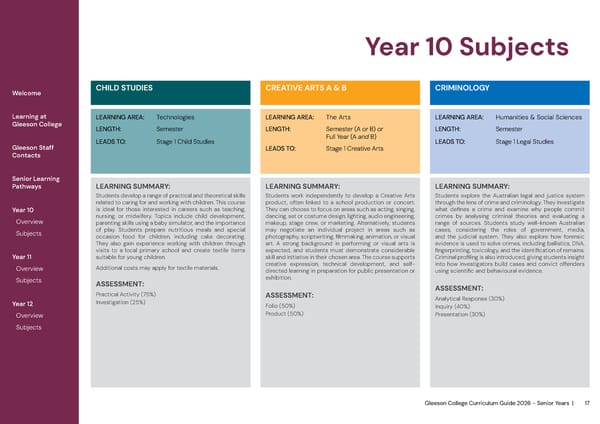Gleeson College Curriculum Guide 2026 - Senior Years | 17 Year 10 Subjects Welcome Learning at Gleeson College Gleeson Staff Contacts Senior Learning Pathways Year 10 Overview Subjects Year 11 Overview Subjects Year 12 Overview Subjects LEARNING SUMMARY: Students develop a range of practical and theoretical skills related to caring for and working with children. This course is ideal for those interested in careers such as teaching, nursing, or midwifery. Topics include child development, parenting skills using a baby simulator, and the importance of play. Students prepare nutritious meals and special occasion food for children, including cake decorating. They also gain experience working with children through visits to a local primary school and create textile items suitable for young children. Additional costs may apply for textile materials. ASSESSMENT: Practical Activity (75%) Investigation (25%) CHILD STUDIES LEARNING AREA: Technologies LENGTH: Semester LEADS TO: Stage 1 Child Studies CREATIVE ARTS A & B LEARNING AREA: The Arts LENGTH: Semester (A or B) or Full Year (A and B) LEADS TO: Stage 1 Creative Arts LEARNING SUMMARY: Students work independently to develop a Creative Arts product, often linked to a school production or concert. They can choose to focus on areas such as acting, singing, dancing, set or costume design, lighting, audio engineering, makeup, stage crew, or marketing. Alternatively, students may negotiate an individual project in areas such as photography, scriptwriting, filmmaking, animation, or visual art. A strong background in performing or visual arts is expected, and students must demonstrate considerable skill and initiative in their chosen area. The course supports creative expression, technical development, and self- directed learning in preparation for public presentation or exhibition. ASSESSMENT: Folio (50%) Product (50%) LEARNING SUMMARY: Students explore the Australian legal and justice system through the lens of crime and criminology. They investigate what defines a crime and examine why people commit crimes by analysing criminal theories and evaluating a range of sources. Students study well-known Australian cases, considering the roles of government, media, and the judicial system. They also explore how forensic evidence is used to solve crimes, including ballistics, DNA, fingerprinting, toxicology, and the identification of remains. Criminal profiling is also introduced, giving students insight into how investigators build cases and convict offenders using scientific and behavioural evidence. ASSESSMENT: Analytical Response (30%) Inquiry (40%) Presentation (30%) CRIMINOLOGY LEARNING AREA: Humanities & Social Sciences LENGTH: Semester LEADS TO: Stage 1 Legal Studies
 2026 Gleeson College Senior Years Curriculum Guide 2026 Page 16 Page 18
2026 Gleeson College Senior Years Curriculum Guide 2026 Page 16 Page 18